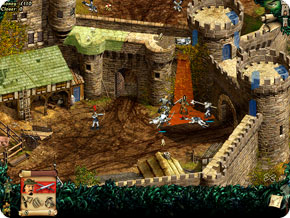
ROBIN HOOD LEGEND OF SHERWOOD MOVIE SERIES
Shot on film and almost entirely on location, Robin Of Sherwood made use of real forests and castles, giving the show an authentic look that couldn’t have been achieved with tailor-made sets – even if the filming of the first series was constantly halted by rain. Where earlier versions of the story often included King Richard as a positive, noble figure, and his brother Prince John as the villain taking advantage of the opportunity for power while Richard is away on a crusade, Robin of Sherwood’s King Richard only cares about war and power and manipulates Robin for his own ends, proving that even a seemingly benevolent colonizer still doesn’t have the colonized’s best interests at heart. The outlaws didn’t just rob from the rich and give to the poor – they fought oppression and stood for a better, fairer England.

Robin and his followers were revolutionary heroes to the downtrodden Saxon peasantry, and the series made much of the idea of a true English people striking a blow against the colonising Normans. In spite of the new elements the show brought to the legend, it stuck to tradition in placing the outlaws in the 12th century, where the backdrop of Richard the Lionheart and the Crusades gave Carpenter the opportunity to explore interesting political themes. It could have spelled the end for Robin Of Sherwood, but Carpenter’s solution was ingenious – the Robin Hood legend had always been hazy on whether Robin was a commoner or a nobleman – so what if there were two Robins?Īfter Paul McGann, Jason Carter, and Neil Morrissey tried out for the role, Jason Connery was cast as Robert of Huntingdon, son of the Earl of Huntingdon, a young noble called to be Herne’s new son and take on the mantle of the Hooded Man, and the leadership of Robin’s former band of outlaws. His departure came in the iconic episode The Greatest Enemy, in which Robin sacrifices himself to save his friends. The idea that Herne would choose a spiritual son to represent him came in handy when, at the end of the second series, Michael Praed decided to leave the show to pursue a career on Broadway. The pagan flavor of the series has also made its way into the popular imagination – Carpenter decided that Robin would not just be a man who decided to fight an oppressive regime, but would be specially chosen for his destiny by Herne the Hunter, an antlered forest god who spoke to Robin via the (consensual) possession of an unnamed shaman, played by John Abineri. The introduction of the Saracen ex-assassin Nasir (played by Mark Ryan) came about more or less by accident, but the character’s presence was significant enough that the writers of Robin Hood: Prince Of Thieves included their own Muslim character, under the impression that this was a standard element of the Robin Hood legend. Robin Of Sherwood brought new elements to the centuries-old Robin Hood story, and incorporated them so fully that they have become part of the legend itself – until Robin of Sherwood, the outlaws never had a Muslim companion. Judi Trott was an intelligent, determined Marion who held her own fighting with the rest of the outlaws, with a pre-Raphaelite look that complemented Praed’s fey athleticism.

Ray Winstone had already appeared in Scum, Quadrophenia, and the gangland drama Fox, establishing his gritty credentials and bringing a tougher, darker energy to the band of outlaws (no longer in green tights and not called the Merry Men, at least not on screen) as a tormented and vengeful Will Scarlet. Michael Praed’s charismatic-yet-otherworldly presence as Robin was the perfect match for the show’s aesthetic, and the more down-to-earth Little John, played by Clive Mantle, was his ideal right-hand man. Much of the success of the show was down to the spot-on casting and the chemistry between the performers. Made by HTV in association with production company Goldcrest Films (which was also behind Chariots Of Fire and Gandhi), its 26 episodes ran on ITV from 1984 to 1986, garnering a positive critical reception and inspiring a fan following that’s still enthusiastically active today. The Robin Hood legend has been retold in countless ways, but one of the most memorable of modern times is Richard Carpenter’s hugely influential 1980s imagining, telling the story of Sherwood’s band of outlaws with a combination of realism and luminous fantasy with its roots in British folklore.


 0 kommentar(er)
0 kommentar(er)
